
The attack of May 13, 1967 at
fire support base Caroline

Camp Caroline or Fire Support Base 11, was manned and under the control of the 9th Division, which had arrived in January 1967, just in time to participate in the big offensives that were planned into War Zone C. When A Company relieved the defenders at Caroline, we were placed under the control of the 9th Division. The Company was exhausted from months of grueling patrols into the enemy strongholds northwest of Saigon. In addition a major upheaval was still being felt by the decision to replace many of the original men with men from other Units and new arrivals in country. It was time to reorganize and get our footing back.
Caroline was set up just off the road connecting Dau Tieng to Tay Ninh. The push pin in the photo above points to the location of the base. I will be recording the recollections from vets who were at Caroline. Ed Smith, our Company Commander through his period, provided much of the details for the story.
Ed Smith begins the story by explaining our deployment:
"We were on Operation Manhattan along the upper Saigon River in early May. We probably had a couple of more days to work that area before we moved on to something else. On very short notice the afternoon of May 5, 1967, we got a change in mission to terminate our participation in Operation Manhattan and to move to Fire Base Caroline.
We shuttled by CH-47 to the fire base, one platoon at a time. I had Burnie Quick and 1st Platoon go out first to check the fire base out and to organize getting our platoons in as the rest of the company moved there. Believe I had First Sgt. Kimura and someone else from the Company CP go with Burnie to help get the company settled in with minimum confusion.
During our time at Fire Base Caroline, 2/12 Infantry and A Company were under the Operational Control of 1st Brigade, 9th Infantry Division. We replaced a Company from the 9th Infantry Division on the Fire Base.
Our mission on Fire Base Caroline as best I recall was to: Secure the fire base and the artillery battery there; conduct our normal patrols and ambush operations; and to conduct road clearing operations along a section of the road between Dau Tieng and Tay Ninh for the daily convoys. In the area was an Engineer Platoon constructing an access road from the main road to the Fire Base, and a Cav Platoon from C/1/10 Cav providing security for the Engineers.
Their position was down
by the main road, very close to a South Vietnamese Outpost by either a small
bridge or culvert on the road. Also in the area, a couple of kilometers closer
to Tay Ninh was another, larger South Vietnamese Outpost. I suspect these
positions were manned by South Vietnamese militia rather than regular ARVN
Soldiers, but I'm not sure. The Cav Platoon also participated with us in the
road clearing operations.
The location of Caroline, as determined through G3 Division records was XT
304498. The features that I recall are at that location, the road, stream, ARVN
Outpost."
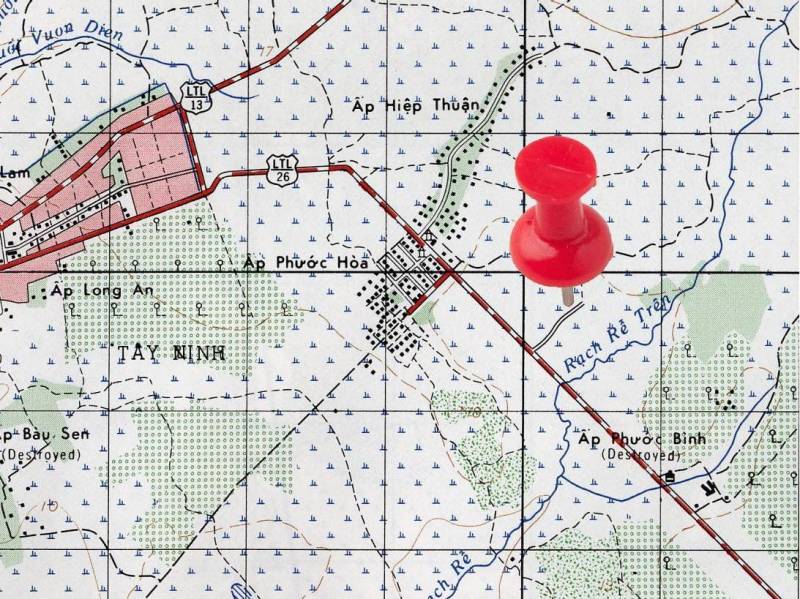
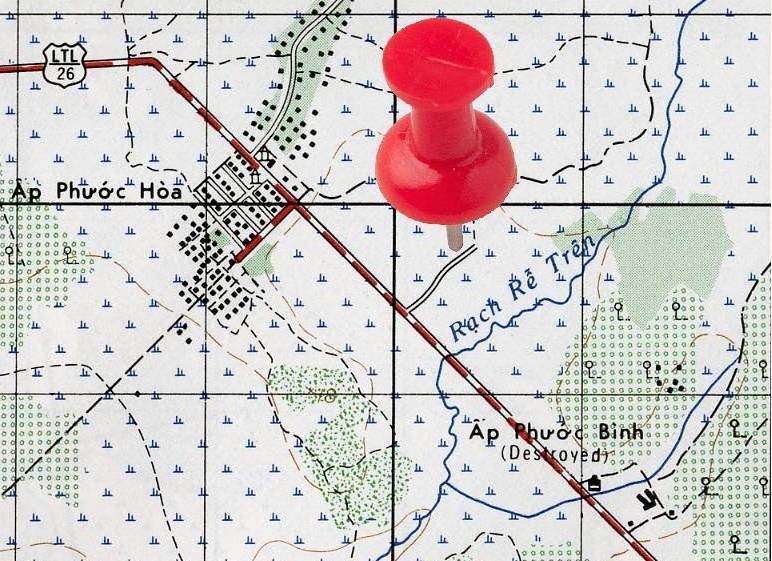
Location east of Tay Ninh Close up map of location
Fire Support Base 11 (Caroline) shows a tranquil, if Spartan existence for the men of A/2/12, it would change dramatically on the night of Saturday, May 13th. Charlie had been canvassing the camp for a while and planned a Saturday evening event that the men who were there would never forget.
Here are some events leading up to that night as told by a few of the men who were there and shared their memories with me.
 Bob Livingston, shown left, begins this story of our Caroline duty with Fred
Berardi, Roger Carter and Ed Smith adding their thoughts:
Bob Livingston, shown left, begins this story of our Caroline duty with Fred
Berardi, Roger Carter and Ed Smith adding their thoughts:
Bob: "It's hard to recall all the details about Caroline and the circumstances regarding the mortar attack of May 13, 1967. I recall that our assignment to this wayside on the road to Tay Ninh was supposed to be a break from the sweeps we had been on and the mission was to cover the road and sweep for mines. I guess it was sort of a security mission. I remember when we set up that we were concerned about putting good strong fighting positions together. Captain Smith was making the rounds checking and commented to me regarding the need for a back wall on my position, sort of a baffle wall. We were pretty busy with some patrols but I assured him that it would be done. Captain Smith's attention to detail and his knowledge certainly contributed to my being able to write this today.
Perhaps a week or so went by and we were settling into a routine, daylight recons, checking the road, assist engineers who sweep for mines, in the evening some ambush patrols out. At night, if my memory serves me, we used some artillery and 81 MM Mortars. There were 2 Tanks there as well and I remember seeing the Armored Guys with folding chairs on the back deck of their units.

Barber cutting hair with a suspicious man in front,
thought to be canvassing area for attack
I remember that there was a Vietnamese, one legged supposedly, former VN Army paratrooper, cutting hair. Capt. Smith had checked his papers with an interpreter and they must have looked solid. I was learning some VN from him while he was learning English. I had gotten a haircut and sort of lost track of time. I remember him saying he would not be back the next day because it was Sunday. That night rather late we were hit with a pretty heavy mortar barrage."
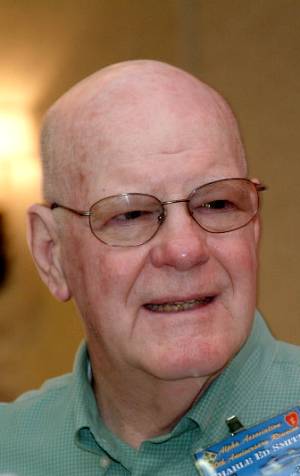 Ed
Smith (shown left at 2007 reunion): "The
attack on Fire Base Caroline occurred on Saturday, May 13, 1967 around 9:20-
9:30 PM.
Ed
Smith (shown left at 2007 reunion): "The
attack on Fire Base Caroline occurred on Saturday, May 13, 1967 around 9:20-
9:30 PM.
When we were hit on Caroline, the first rounds came in on the artillery position, causing a number of casualties there. Then, they walked the fire through the fire base hitting the Company CP and Mess Tent areas. That was where Bob Livingston was hit. If I recall correctly, the bunker the cooks stayed in took a direct hit, but none of the Mess People took a scratch. They were all in the Mess Tent playing poker. I recall seeing the big pots they cooked in. They looked like a colander that you drain spaghetti with because of so many fragment holes."
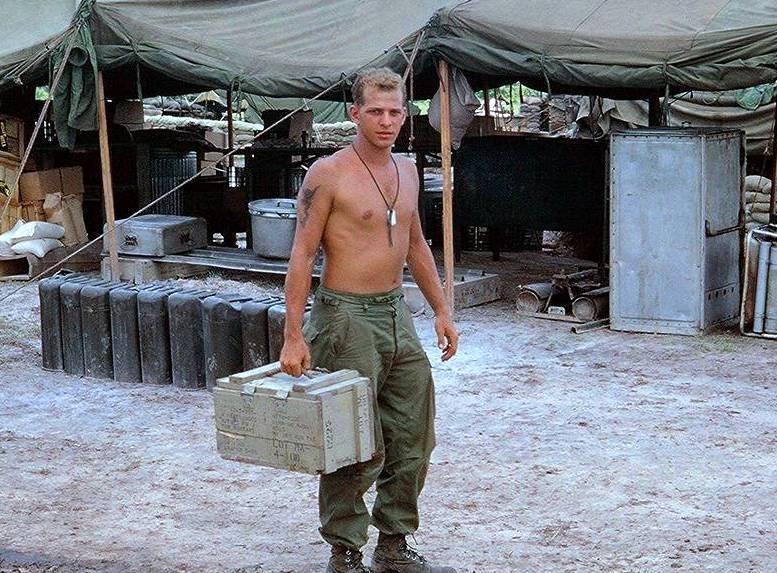
Fred Berardi, shown at Caroline, in front
of the mess tent before the attack
 Fred
Berardi, shown left, picks up the story with his recollection:
Fred
Berardi, shown left, picks up the story with his recollection:
"Funny how things
turn out sometimes. On the evening of the mortar attack I was sharing a bunker
with Bob Livingston and as nightfall approached a member of the mess crew walked
over to our bunker and asked me if I wanted to get into a poker game in the mess
tent. I never refused an invitation to a poker game and so I agreed to go. Bob
was cross with me as he had been on me for days to write a letter home to my
folks and I had neglected to do it. I told them I would write the following day
and headed out to the poker game.
Later that evening a mortar attack began and the thought
suddenly entered my mind that we couldn't get to the mess tent bunker because it
was hit fairly early in the attack.
So here I was, along with the other gamers, hugging the walls of the mess tent
which had a 3 foot wall of sandbags surrounding it. Right about then I was ready
to jump inside my steel pot, but I didn't have it with me. In fact I didn't have
my weapon with me either! I was defenseless. I had left all my gear in my
bunker.
After the mortars subsided I ran as fast as I could to my bunker which took a
hit. My gear along with my weapon was destroyed. I jumped out of the bunker and
ran to the defensive perimeter positions in anticipation of a manned ground
assault. I found a machine gun position and was given a 45 handgun to defend
myself. Luckily the ground assault never arrived. I didn't know how Bob
Livingston, my bunker buddy, fared in the mortar attack and suspected the
worse."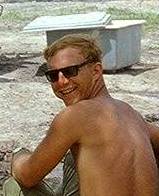
Bob Livingston: "The VC walked the mortar fire all along and through the positions very thoroughly. I remember Lloyd Boston., was sleeping on the back of the company truck near my bunker. I was outside. I had 2 hand grenades on top of the baffle wall. Both Boston, shown right, who jumped off the truck and I dove into the same position. Boston had hit the tail gate as he did his half gainer off the truck
We had
a firing port facing towards the line.
I remember seeing this fiery orange ball at the baffle
wall. I can remember the concussion and the blast's heat throwing us against the
wall inside. The explosions around us were absolutely deafening. Neither of us
could hear a darn thing. We quickly left the position and I went across the open
ground figuring they might start a ground assault toward the CP. Captain Smith
was busy on the radio. I crawled back to the bunker and then realized that I
had some blood on my left side, left knee, and blood was coming from a hole in
my left foot by the toes up through the top of the boot and some small pieces in
my hands . We loaded guys on choppers and I noticed that the company jeep had
gotten damaged. I remember that night the tankers or APC guys had taken a hit
and they were burned rather badly. I was on the last
chopper out and clearly
remember leaning against the rifle and seeing a hole materialize instantaneously
on the inside deck of the chopper floor and up through the roof. I'm thinking
"they are shooting, at us, and it's very close". In the MASH unit we were
triaged immediately and I remember being on an operating table looking across to
8 or 9 tables where the docs and nurses were very workin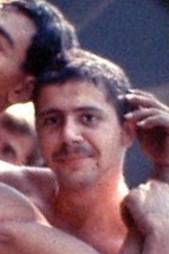 g.
I remember a nurse stitching up a buck naked guy cut from his upper left
shoulder across his back and down his side. The flesh cut was large enough that
she used two hands to pull the flap up after cleaning it with iodine so she
could get another nurse to start the sutures. I think about this and really
consider myself a lucky guy that my Commanding Officer took some time to make an
on the spot correction. That wall saved me and
Boston. Alpha company dug a lot of holes all over that part of Vietnam. Most
were straight into the ground. This was different because virtually everything
on Caroline was of constructed material. Funny part here… when they moved us to
the hospital guess who was in the bed next to mine? Ed Belisle! (shown
right). He had a large number of stitches in his chest and he refused to get on
the chopper to go to Cu Chi Hospital because he wanted to borrow some MPCs
first. He did indeed get MPCs, $10.00 worth, and we went to the Cu Chi Hospital.
g.
I remember a nurse stitching up a buck naked guy cut from his upper left
shoulder across his back and down his side. The flesh cut was large enough that
she used two hands to pull the flap up after cleaning it with iodine so she
could get another nurse to start the sutures. I think about this and really
consider myself a lucky guy that my Commanding Officer took some time to make an
on the spot correction. That wall saved me and
Boston. Alpha company dug a lot of holes all over that part of Vietnam. Most
were straight into the ground. This was different because virtually everything
on Caroline was of constructed material. Funny part here… when they moved us to
the hospital guess who was in the bed next to mine? Ed Belisle! (shown
right). He had a large number of stitches in his chest and he refused to get on
the chopper to go to Cu Chi Hospital because he wanted to borrow some MPCs
first. He did indeed get MPCs, $10.00 worth, and we went to the Cu Chi Hospital.
Roger Carter (shown in 1967 and at recent reunion) continues his recollection of that evening:
 "On
the night that we got mortared, we could see the flashes from the mortar tubes.
They were straight ahead o
"On
the night that we got mortared, we could see the flashes from the mortar tubes.
They were straight ahead o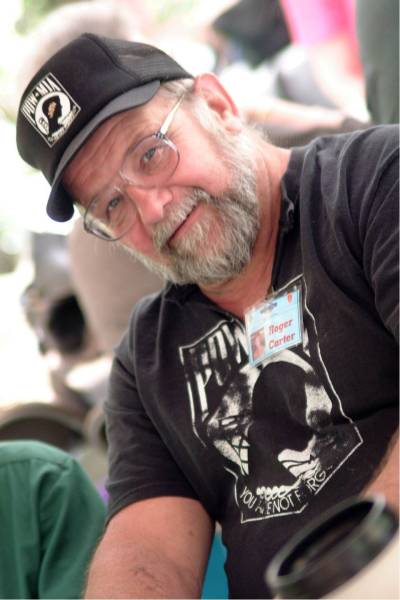 f
our bunker. I told the guys that I was going to go back to the Forward Observer
for the artillery and tell them the direction that they were coming from so that
they could return fire. On my way to the FO I saw a mortar hit a bunker and
heard some hollering from inside, but I needed to get the info back on the
mortar location to the FO so I raced on. After alerting the FO, I worked my way
back to my bunker. By now "Puff the Magic Dragon" had arrived overhead and was
doing his thing.
f
our bunker. I told the guys that I was going to go back to the Forward Observer
for the artillery and tell them the direction that they were coming from so that
they could return fire. On my way to the FO I saw a mortar hit a bunker and
heard some hollering from inside, but I needed to get the info back on the
mortar location to the FO so I raced on. After alerting the FO, I worked my way
back to my bunker. By now "Puff the Magic Dragon" had arrived overhead and was
doing his thing.
Mortars were coming in all around as I raced back to my position. I returned to
my bunker, which I shared with Pete Cullen and a couple of other GIs. The bunker
to our left took a direct hit from a recoilless rifle that night, fortunately it
was empty, as we discovered the next morning.
I thank God all the time for protecting me while I was there and all that we
went through."
Ed Smith : "What I don't understand, and
probably never will, is why John Lattin didn't come up on the net and tell us
that 2nd Platoon could see the muzzle flashes. Maybe he couldn't see them from
where he was. I just don't know. Luckily for us, Roger's gallant race back to
the Company CP allowed us to direct fire to the source of the mortar fire.
There was a mad dash made by1st Platoon to get back from their ambush position
and deploy at the Engineer/Cav position down by the road. We had a difficult
situation there. We were hit first on the main position, the NCOs from the Cav
Platoon went to the tank, which took a hit from an RPG. All the NCOs were
casualties and the only person I could talk to there was a young SP4 from the
Cav Platoon. He held things together until Burnie Quick could get there to take
command of the position. I'd like to acknowledge the outstanding performance
from that ambush patrol, led by Larry Walter and Burnie to quickly assume the
leadership in that sector.
I do not recall how many casualties A/2/12 suffered that night. The death toll
was two as Dennis Hubbard was killed in the initial attack and Paul Manske died
of ground fire. (Editorial Note: I show in my diary that 10 men from A/2/12 were
injured but survived their wounds they received that night).
Artillery Battery was hit worse than we were. Think they had a couple of crews
out firing Harassing & Interdiction Fires, and they also had either 3 or 4 KIA
and some wounded. The initial mortar rounds came in and caught
them exposed. (Ed. Note: I was told by Bob Livingston that he understood that 30
men manning the Fire Base became casualties).
One of the things I recall from the morning after the attack at Caroline was something one of the young Sergeants from 4th Platoon did. He made a diagram of the Fire Base, then went around and marked the shell craters made by the enemy mortars. I believe he counted 100 craters, 76 of which were inside our perimeter. Contrary to the impression given by the photo, it was a pretty small Fire Base. That was good shooting on their part."
In appreciation for the time we spent supporting the 9th Division, the 2/12 Btl. Commander, Colonel Kenneth E. Buell received this Letter of Appreciation.
A Company was singled out for their tenacious defense of Fire Support Base 11.
Captain Ed Smith, forever humble, provided the documents to me and requested that any reference to him would be purged from publication. I am taking responsibility for denying that request because the document would not be historically correct and not properly mirror what transpired that night. The leaders and the men who manned that base camp deserve the recognition that was reflected in this document.
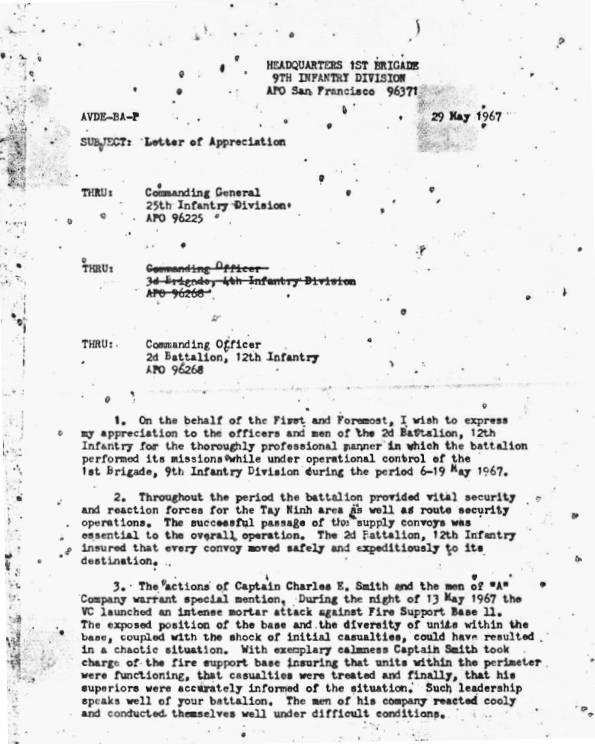
The document was delivered through Major General Tillson, Commander of the 25th Division and read in part:
The actions of Captain Charles E. Smith and the men of A Company warrant special mention. During the night of 13 May, 1967 the VC launched an intense mortar attack against Fire Support Base 11. The exposed position of the base and the diversity of units within the base coupled with the shock of initial casualties could have resulted in a chaotic situation. With exemplary calmness, Captain Smith took charge of the fire support base ensuring that units within the perimeter, were functioning, that casualties were treated and finally, that his superiors were accurately informed of the situation. Such leadership speaks well of your battalion. The men of his Company reacted coolly and conducted themselves well under difficult conditions.
Postscript to the Caroline period and the battle:
Bob Livingston: "After two days at Cu Chi Hospital, Ed Belisle and I had an incident when a Nurse Senior Officer came to order us from the beer tent. We had climbed out of the beds snuck out and got to a beer tent. That was only 2 days after our arrival, on crutches, at night. That was sure funny and that beer tasted so good. First Sgt. Springer came to see us a few days later. Everyone was glad to see him. That's what I remember about Caroline. Nice name for a hellish little spot in Vietnam.
Here is the rest of the story:
This story was written as a cover story for the March 2005 edition of ALPHA'S PRIDE, A/2/12's quarterly newsletter. Until that time, few were aware of the heroics played by Roger Carter in his efforts to suppress the fire that was originating in front of his position. When Ed Smith was challenged to reward Roger for his gallantry, he was motivated to see what could be done to rectify the oversight of 38 years earlier. . With written statements from witnesses Talbert Turner and Peter Cullen, he set about putting into motion a request for a Medal for Valor for Roger. With the help of Representative Zach Wamp, 3rd District Tenn., (Ed’s congressional rep) and the helpful staff in his office, he submitted the request to the Army Department for consideration.
ORIGINAL STATEMENT (written
for consideration)
November 10, 2005
On May 13, 1967, I was serving as Company Commander, Company A, 2d Battalion,
12th Infantry. We were working out of Fire Support Base Caroline at approximate
Grid Coordinates XT 412443, immediately North of the road between Tay Ninh and
Dau Tieng. An aerial photograph of the Fire Support Base taken by one of our
Medics is attached.
Our mission was to secure the Artillery Battery on the Fire Support Base,
conduct Patrols and Ambush operations, and each day to clear a portion of the
road between Tay Ninh and Dau Tieng.
Also in the area, positioned near the Fire Support Base and immediately by the
road, were an Engineer Platoon from Company C, 4th EN BN that was constructing
an access road from the main road to the Fire Support Base, and a Platoon from
Troop C, 1st Squadron, 10th CAV, which was providing security for the Engineer
Platoon.
The night of May 13, 1967, approximately 2130 hours, we came under very heavy
and accurate attack by enemy mortar and recoilless rifle fire, small arms and
automatic weapons. We were hit first on the main position and shortly after, the
Engineer and Cavalry position by the main road came under attack. The initial
rounds caused a number of casualties in our 2d Platoon and especially in the
Artillery Battery as gun crews firing Harassing & Interdiction Fires were
exposed in their gun pits. A M-48 Tank from the Cavalry Platoon was hit in the
turret by an Rocket Propelled Grenade and that platoon incurred a number of
casualties as well, especially among the Non-Commissioned Officers. Our initial
response to the attack included a request for immediate gunship support.
As the attack continued, our attached Artillery Forward Observer came to my
position at the company radio jeep and gave me information about the enemy
firing position. That information was relayed to an enroute USAF AC-47 gunship.
The gunship was soon over our position and began placing mini-gun fire on the
reported enemy firing position. The enemy fire ceased almost immediately.
At the time, the situation was very intense and I did not query our Artillery
Forward Observer as to how he determined the location of the enemy firing
position, and unfortunately, we did not revisit the subject after the attack.
Only recently, over 38 years after the event, did I become aware that one of the
soldiers from our 2d Platoon, then PFC Roger K. Carter, US 52683947, observed
the muzzle flash from the enemy mortars, and on his own initiative and at great
personal risk to himself, worked his way across the exposed fire base through
heavy, intense, accurate, and continuous enemy fire. He located our Artillery
Forward Observer and reported the enemy location. PFC Carter’s report was the
basis for the information passed to me and relayed to the USAF AC-47 gunship.
PFC Carter, still under intense enemy fire and at great personal risk, then
worked his way back across the firebase to his fighting position and prepared to
help defend the firebase against a ground assault.
The significance of PFC Carter’s action was to save us very valuable minutes in
getting the USAF AC-47 gunship over the enemy position and in engaging the
target. The direct result of his action was to cause the enemy to cease fire and
save us additional casualties. His report was the first indication we had as to
location of the enemy firing position. To this day, I am amazed that he made it
across the firebase to the Company Command Post and back to his fighting
position without becoming a casualty himself.
US Forces suffered a total of 7 dead on the position. Two from Company A, 2d
Battalion, 12th Infantry, four from the Artillery Battery, and the Cavalry
Platoon had one killed when the M-48 Tank was struck by an RPG. While I do not
recall the exact number of US wounded during the attack, then SSG Robert
Livingston, who was wounded during the attack and evacuated on the last MEDEVAC
Helicopter, believes approximately 30 US personnel were wounded and evacuated
from the position.
Charles E. Smith
LTC, US Army – Retired
-Here is the final affidavit-
AFFIDAVIT
STATE OF TENNESSEE, )
COUNTY OF ANDERSON.)
I, CHARLES E. SMITH, having been first duly sworn, deposes under oath and states as follows:
I recommend former SP4 Roger K. Carter, US 52683947, for award of the Bronze Star Medal For Heroism for his actions the night of 13 May 1967 in Tay Ninh Province, The Republic of Vietnam.
On 13 May 1967, I was serving as Company Commander; Company A, 2d Battalion, 12th Infantry in The Republic of Vietnam. We were working out of Fire Support Base 11 (also referred to as Fire Support Base Caroline) in Tay Ninh Province at approximate Grid Coordinates XT 304498, immediately North of the road between Tay Ninh and Dau Tieng. An aerial photograph of the Fire Support Base taken by one of our Medics and map section are included.
Our mission was to secure Battery C, 2d Battalion, 13th Field Artillery on the Fire Support Base, conduct Patrols and Ambush operations, and each day to clear a section of the road between Tay Ninh and Dau Tieng.
Also in the area, positioned near the Fire Support Base and immediately by the road, were an Engineer Platoon from Company C, 4th Engineer Battalion, that was constructing an access road from the main road to the Fire Support Base, and a Platoon from Troop C, 1st Squadron, 10th Cavalry, which was providing security for the Engineer Platoon.
The night of 13 May 1967, approximately 2227 hours, we came under very heavy and deadly accurate attack by enemy mortar and recoilless rifle fire, automatic weapons and small arms. We were hit first on the main position, and shortly after, the Engineer and Cavalry position by the main road came under attack. The initial rounds caused a number of casualties in our 2d Platoon and especially in the Artillery Battery as gun crews firing Harassing & Interdiction Fires were exposed in their gun pits. A M-48 Tank from the Cavalry Platoon was hit in the turret by a Rocket Propelled Grenade and that platoon incurred a number of casualties as well, especially among the Non-Commissioned Officers. Our initial response to the attack included a request for immediate gunship support.
As the attack on our position continued, our attached Artillery Forward Observer came to my position at the company radio jeep and gave me information about the location of the enemy firing position. That information was relayed to an enroute USAF AC-47 gunship. The gunship was soon over our position and began placing mini-gun fire on the reported enemy firing position. The enemy fire ceased almost immediately.
At the time, the situation was very intense, and I did not query our Artillery Forward Observer as to how he determined the location of the enemy firing position, and unfortunately, we did not revisit the subject after the attack.
Only recently, over 39 years after the event, did I become aware that one of the soldiers from our 2d Platoon, then PFC Roger K. Carter, US 52683947, observed the muzzle flash from the enemy mortars, and on his own initiative and at great personal risk to himself, worked his way across the exposed fire base through heavy, accurate, and continuous enemy fire. He located our Artillery Forward Observer at the Company Command Post and reported the enemy location. PFC Carter’s report was the basis for the information passed to me and relayed to the USAF AC-47 gunship.
PFC Carter, still under intense enemy fire and at great personal risk, then worked his way back across the firebase to his fighting position and prepared to help defend the firebase against a ground assault.
The significance of PFC Carter’s action was to save us very valuable minutes in getting the USAF AC-47 gunship over the enemy position and in engaging the target. The direct result of his action was to cause the enemy to cease-fire and save us additional casualties. His report was the first indication we had as to the location of the enemy firing position. To this day, I am amazed that he made it across the firebase to the Company Command Post and back to his fighting position without becoming a casualty himself.
US Forces suffered a total of 7 dead on the position. Two from Company A, 2d Battalion, 12th Infantry (PFC Dennis L. Hubbard, US 54809125, Multiple Fragmentation Wounds, and PFC Paul E. Manske, US 56453759, Gun, Small Arms Fire), four from the Artillery Battery, and the Cavalry Platoon had one killed when the M-48 Tank was struck by an RPG. Twenty-six wounded were evacuated from the position. Except for the heroic action by then PFC Carter, we would have suffered even more casualties. Had I known of his actions at the time, I would have submitted a Recommendation For Award for him then.
PFC Roger K. Carter’s selfless act of heroism makes him most deserving for award of the Bronze Star Medal For Heroism.
At the time, the 2d Battalion, 12th Infantry was part of 3d Brigade, 4th Infantry Division, based at Dau Tieng by the Michelin Rubber Plantation. The 3d Brigade, 4th Infantry Division was under the Operational Control of the 25th Infantry Division. During the period 6 – 19 May 1967, including the date of the attack, the 2d Battalion, 12th Infantry was under the Operational Control of 1st Brigade, 9th Infantry Division which was also under the Operational Control of the 25th Infantry Division.
Information about the attack on Fire Support Base 11 (also referred to as Fire Support Base Caroline) is contained in official unit records for the 25th Infantry Division (G-2 and G-3 Staff Journals), and the Staff Journal for HQ, 3d Brigade, 4th Infantry Division. Copies of those official unit records for 13 – 14 May 1967 were made at the National Archives at College Park, MD and are included as supporting documents to this Recommendation For Award. Also included is a copy of a Letter of Appreciation dated 29 May 1967 from Colonel Donald A. Seibert, Commanding, 1st Brigade, 9th Infantry Division, through the Commanding General, 25th Infantry Division and the Commanding Officer, 3d Brigade, 4th Infantry Division to the Commanding Officer, 2d Battalion, 12th Infantry. The Letter of Appreciation includes comments about the attack on Fire Support Base 11. E-Mail dated 13 July 2006 from M. A. Gerda, Modern Military Records, Textual Archives Services Division, National Archives, indicates that “The records of the 2d Battalion, 12th Infantry do not appear to contain any records covering 13 – 14 May 1967.” Records of the 2d Battalion, 12th Infantry for those dates are missing from the National Archives.
To the best of my knowledge, I certify the events described above to be true and correct. Further, the Affiant saith not.
__________________________
Charles E. Smith
LTC, US Army (Retired)
Subscribed and sworn to before me this _____ day of September, 2006.
_____________________________
Notary Public
After organizing many testimonials and documents collected at the National Archives in Washington DC, he forwarded the evidence and waited for a reply. He finally got a call in January, 2007 to come to the Representative Wamp's office. Ed feared the worse or a request for more data. When he got there, the information packet was given to him as he held his breath and opened it. The request was approved! There was not a dry eye in the office as the staff people understood the significance of the effort. Roger received his Bronze Star for Valor almost forty years after the fact .
On June 2nd, 2007, almost 40 years to the day after his heroics, Roger carter was presented his Bronze Star by Brigadier General Steven Scorzato the Assistant Adjutant general for the state of Connecticut, our reunion sight for that year. The citation citation as it was written up:
Department of the Army
US Army Human Resources Command
Permanent Order 355-6, Dated 21 December 2006
Announcement is made of the following award
Bronze Star Medal with “V” Device,
Awarded to Then Specialist Four Roger K. Carter, United States
Army For heroic achievement on 13 May 1967, while serving with
Company A, 2d Battalion, 12th Infantry, 25th Infantry Division in
The Republic of Vietnam. On this date, his unit came under
heavy attack from enemy mortars. Specialist Carter observed
the enemy mortar position and at great personal risk,
maneuvered across the firebase, through intense mortar fire, to
report the enemy’s location. His actions allowed the company
leadership to direct a United States Air Force gunship, which
silenced the enemy mortar position and prevented additional
casualties. Specialized Carter’s actions were in keeping with the
highest traditions of the military service and reflect great credit
upon himself, his unit and the United States Army.
Given under my hand in the City of Washington, this 2d Day of
January 2007, Francis J. Harvey, Secretary of the Army
Jon Palmer had the honor of reading the citation. It was a proud moment for Roger, his wife, Joanna, and his granddaughter’s Bethany and Caitlin, traveling from Ohio for this day. It was even more satisfying for the men of A/2/12, some of whom may not have survived that night when a young man with nothing but raw courage ran through a hail of mortar fire to save the lives of his brothers in his Company. Congratulations to Roger and a well done for Ed Smith (tireless in his efforts to see that Roger received the recognition), Talbert Turner, for inspiring the effort on behalf of his buddy Roger and his written description of the action that night, and Peter Cullen, whose precise descriptions of the actions that night relative to Carter’s run to glory was important to the successful rewarding of this award.
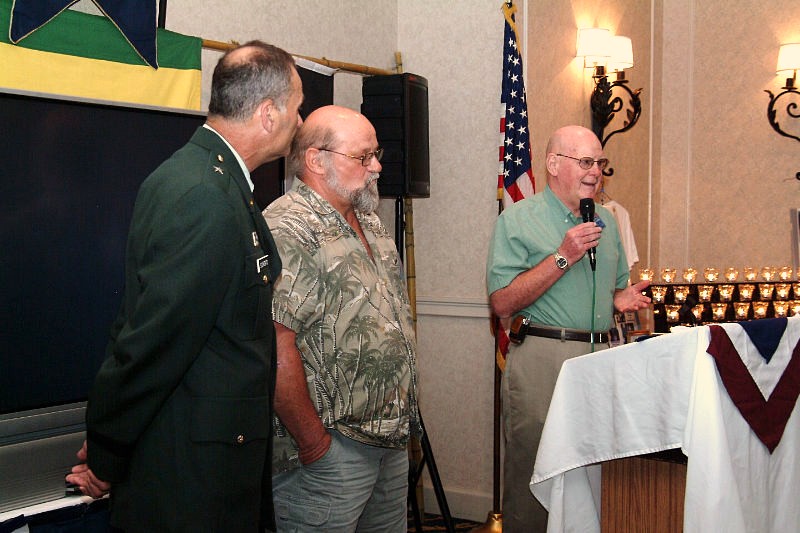

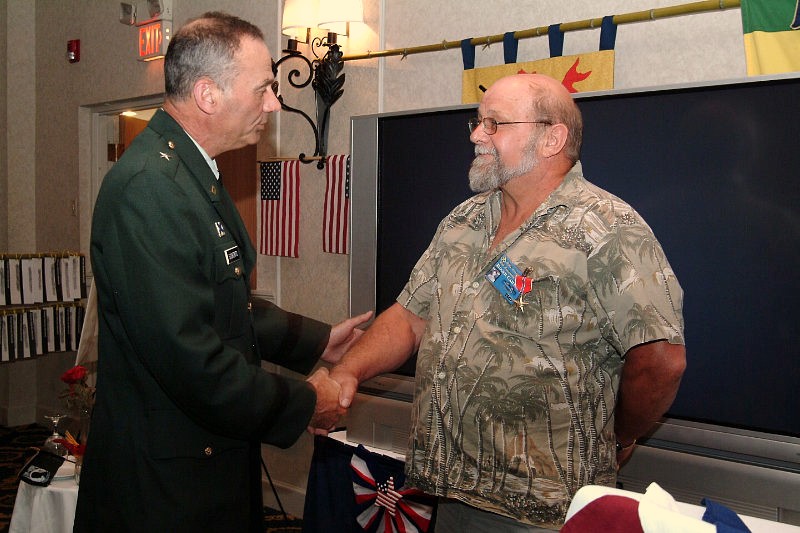

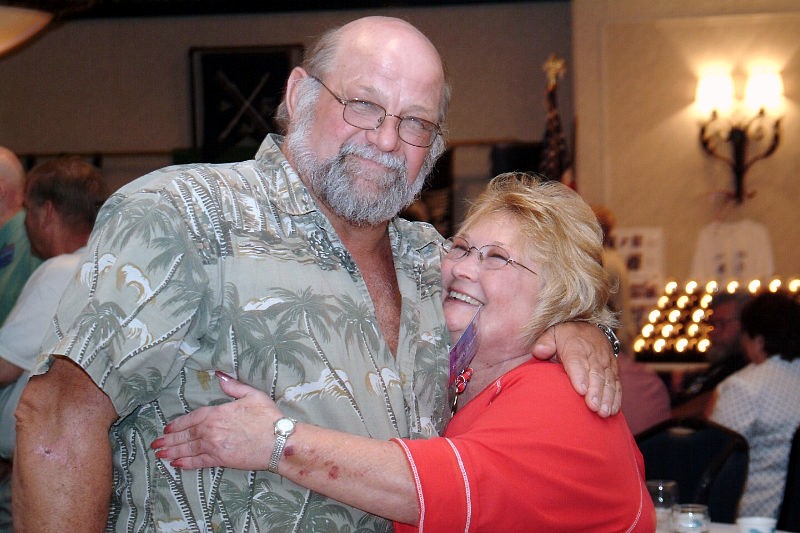

Picture 1: Ed Smith, describing the attack of May 13th while General Scorzato and Roger carter look on.
Picture 2: The pinning of the medal
Picture 3: General Scorzato extending a congratulatory handshake to Roger
Picture 4: The Bronze Star certificate presented to Roger
Picture 5: Roger shown with his loving wife, Joanna
Picture 6: Joanna, Roger, his granddaughters, Bethany and Caitlin, who traveled from Ohio to share this magic moment with their granddad.